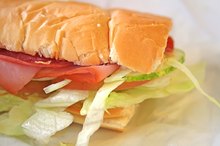How Do Fast Foods Affect Your Life?
The use of fast food restaurants has risen in the past decade as parents become busier and look for a quick, convenient and inexpensive way to feed their families. Unfortunately, unless consumers read nutrition information and make healthy choices, their fast food meals come at a cost to their health and their appearance.
Poor Nutrition
A 2010 report of the Rudd Center for Food Policy and Obesity at Yale University highlighted many nutritional inadequacies in fast food menus as they pertain to children. Their study of 3,039 possible kids' meal combinations at the largest fast food chains in America demonstrated that only 12 meals met nutrition criteria for preschoolers, and 15 met nutrition criteria for older children. The researchers found that an average meal provided 1,000 calories, far more than a child needs, and that snacks and desserts contained five times more than the 200 to 300 calories recommended by the American Dietetic Association for these foods. Eating too many calories contributed to obesity, particularly when the children were also inactive, but their diets were found to be low in fiber, vitamins and minerals.
Cardiovascular Disease
Benefits of Eating Homemade Meals
Learn More
Eating fast food may contribute to cardiovascular disease. Sodium, a major factor in developing heart disease, should be limited to 1,500 mg per day, according to the American Heart Association. In a study of 6,580 fast food meals, the New York Health Department found that 57 percent contained more than the daily sodium limit, according to Help Guide. Limiting saturated fat in the diet helps to reduce the risk of heart disease but fast food meals often provide extreme amounts of fat. For example, a Double Whopper with cheese, an apple pie and a medium order of fries contains more saturated fat than an adult should eat in two days.
Insulin Resistance and Diabetes
A 32-oz Big Gulp size of regular cola contains 425 calories, more than one third of the average woman's total intake for the day. These sugary, high-calorie drinks and other fast food items contribute to insulin resistance and type 2 diabetes, says Mark Pereira, Ph.D., lead researcher in study published in the January 2005 issue of "The Lancet." His study of more than 3,000 young adults over a period of 15 years demonstrated that the subjects who ate frequently at fast food restaurants gained 4.5 kg of weight more than those who ate fast food infrequently, and also had twice the increase in insulin resistance.
Cost
Factors That Affect Your Food Choices
Learn More
Some fast food items cost about the same as it would cost you to prepare a similar meal at home, according to MayoClinic.com. A hamburger, for example, costs approximately 25 cents an oz to make a home and 29 cents an ounce at a fast food restaurant. Surprisingly, the healthier foods such as salads often cost more than so-called value meals that include a sandwich, fries, drink and dessert, says Timothy Harlan, M.D. in a 2007 article published on his website, DrGourmet.com. Other costs to consider when deciding between a homemade meal and a fast food meal include the cost of driving to the restaurant, preparation time and the cost of buying food transported from a distance versus buying locally.
Lifestyle
More fast food restaurant meals mean fewer meals at home as a family, a change that may affect family cohesiveness. Eating together at the dinner table on a regular basis allows parents and children to talk in a relatively relaxed environment, as opposed to the noisy, frenetic atmosphere at a fast food restaurant. Although parents may be able to model healthy eating behavior at the restaurant, they have more control over meals at home with respect to portion size and choice of food. Eating on the run also prevents people from eating mindfully and paying attention to their emotions rather than eating to comfort themselves.
Related Articles
References
Writer Bio
Marcy Brinkley has been writing professionally since 2007. Her work has appeared in "Chicken Soup for the Soul," "Texas Health Law Reporter" and the "State Bar of Texas Health Law Section Report." Her degrees include a Bachelor of Science in Nursing; a Master of Business Administration; and a Doctor of Jurisprudence.









